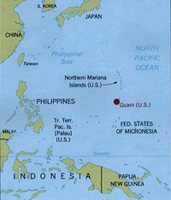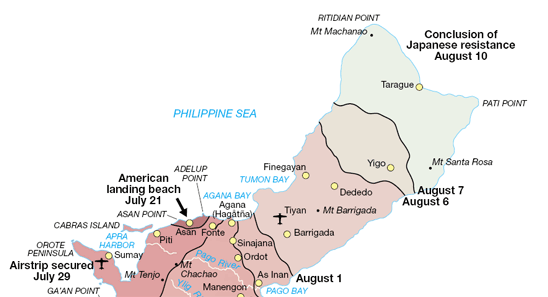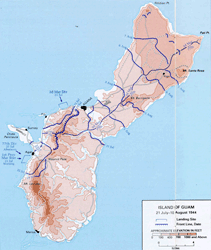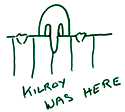| Join | Official Historian | City of Stamford | Blog | About Us | |
| Jewish Historical Society | Civil War Roundtable | Contact Us | |
|
|
|
|
The Stamford Historical Society PresentsPride and Patriotism: Stamford’s Role in World War II
|
 full size map of region |
The Battle of Guam was fought on the island of Guam in the Mariana Islands from 21 July to 10 August 1944. Guam, the largest island in the Marianas, measuring 30 miles long and 9 wide, was captured by the Japanese on 11 December 1941. By 1944 the Japanese had garrisoned many troops there. Guam needed to be recovered so Allied forces could use it as a base of operations for further assaults against the Philippines and the Japanese mainland. It had a deep water port at Apra and two airfields large enough to be used by the B-29 Superfortress bombers.

National Parks Service map of battle
The Allied invasion plan called for heavy aerial bombardment to be followed by coastal shelling. Resistance on Saipan and the Japanese carrier attack (Operation A-Go) forced the postponement of the invasion of Guam until late July. Guam’s location ringed by reefs, cliffs and pounding surf, made landing difficult. Yet on 21 July American forces landed on both sides of the Orote Peninsula on Guam’s west side. The 3rd Marine Division landed near Agana to the north of Orote and the 1st Provisional Marine Brigade landed near Agat on the south side. The 77th had a harder landing. Lacking LVTs, they were forced to wad ashore from the edge of the reef. By the evening of that first day, beachheads 2 km deep had been established. The Japanese attempted several counterattacks over the next few days, most often at night. They also attempted to infiltrate American lines; but each time they made some progress, they did so with heavy losses and were ultimately repulsed. Lt. General Takeshi Takashima, commander of the 18,500 Japanese defenders, was killed and Lt. General Hideyoshi Obata took command.
The Japanese faced two Marine Divisions under the command of Major General Roy S. Geiger.

complete map of th island, large image
It was difficult for the American troops to keep their lines of supply open, as landing ships could not breach the reef and amphibious vehicles were scarce. On 30 July the Orote airfield and Apra harbor were captured. By August the Japanese were low on food and ammunition. Obata withdrew to the south to make a stand in the mountains in the central part of the island. However, with no hope of resupply or reinforcement, the most Obata could do was hold out for a few more days. Rainy conditions and thick jungles helped the Japanese defenders but after an engagement at Mt. Barrigada from 2-4 August the Japanese line collapsed. The Japanese refused to surrender and almost all were killed. A small number took refuge in the jungle and on 8 December 1945 they ambushed and killed three U.S. Marines. On 24 January 1972 Sgt. Shoichi Yokoi was found by hunters. He had lived alone in a cave for 27 years.
Japanese casualties were some 18,000 killed and 485 POWs. The American forces suffered 3000 killed and 7122 wounded.
After Guam was secured it was made a base for Allied operations. Seabees constructed five airfields and B-29 bombers took off from there to Japan. see Lew Jackson's Interview
| Edward Domagala Jack Golden |
The Battle of Guam 1944 Guam, Operations of the 77th Division, 21 July - 10 August 1944 with many links! Pacific and Adjacent Theatres 1943 (map) |
I Introduction
Introduction
Veterans
Battles
Stamford Service Rolls
Homefront
Exhibit Photos
Opening Day